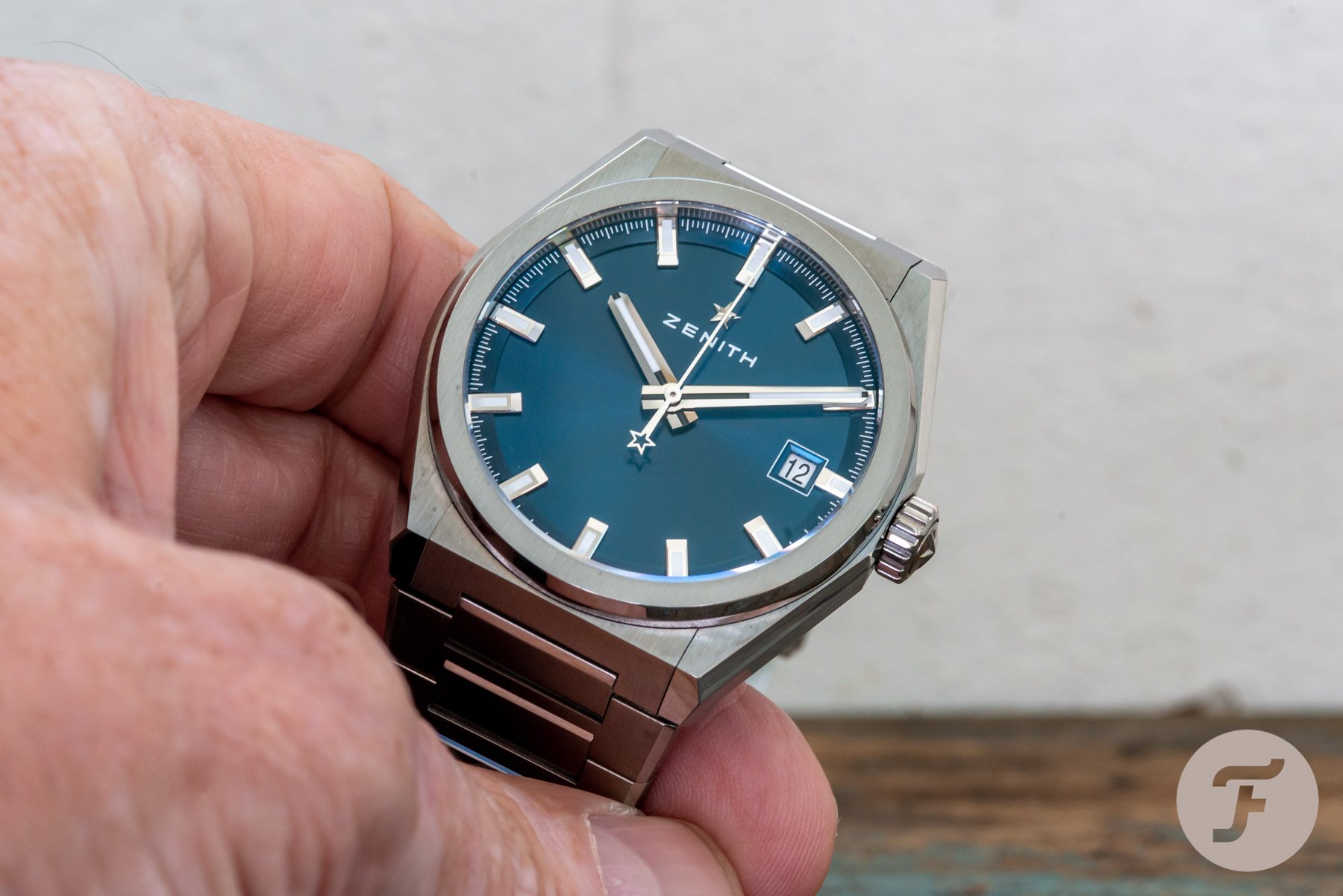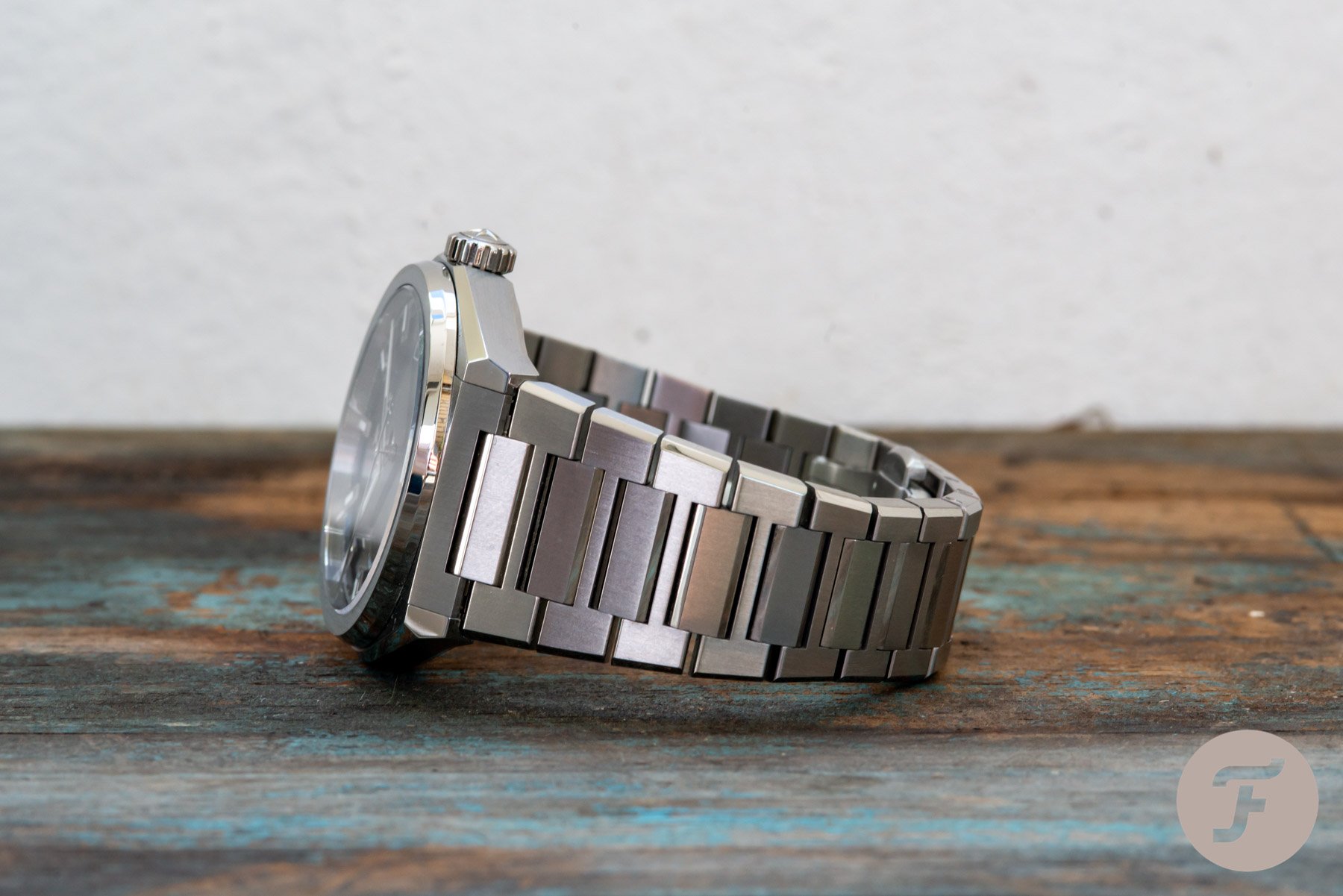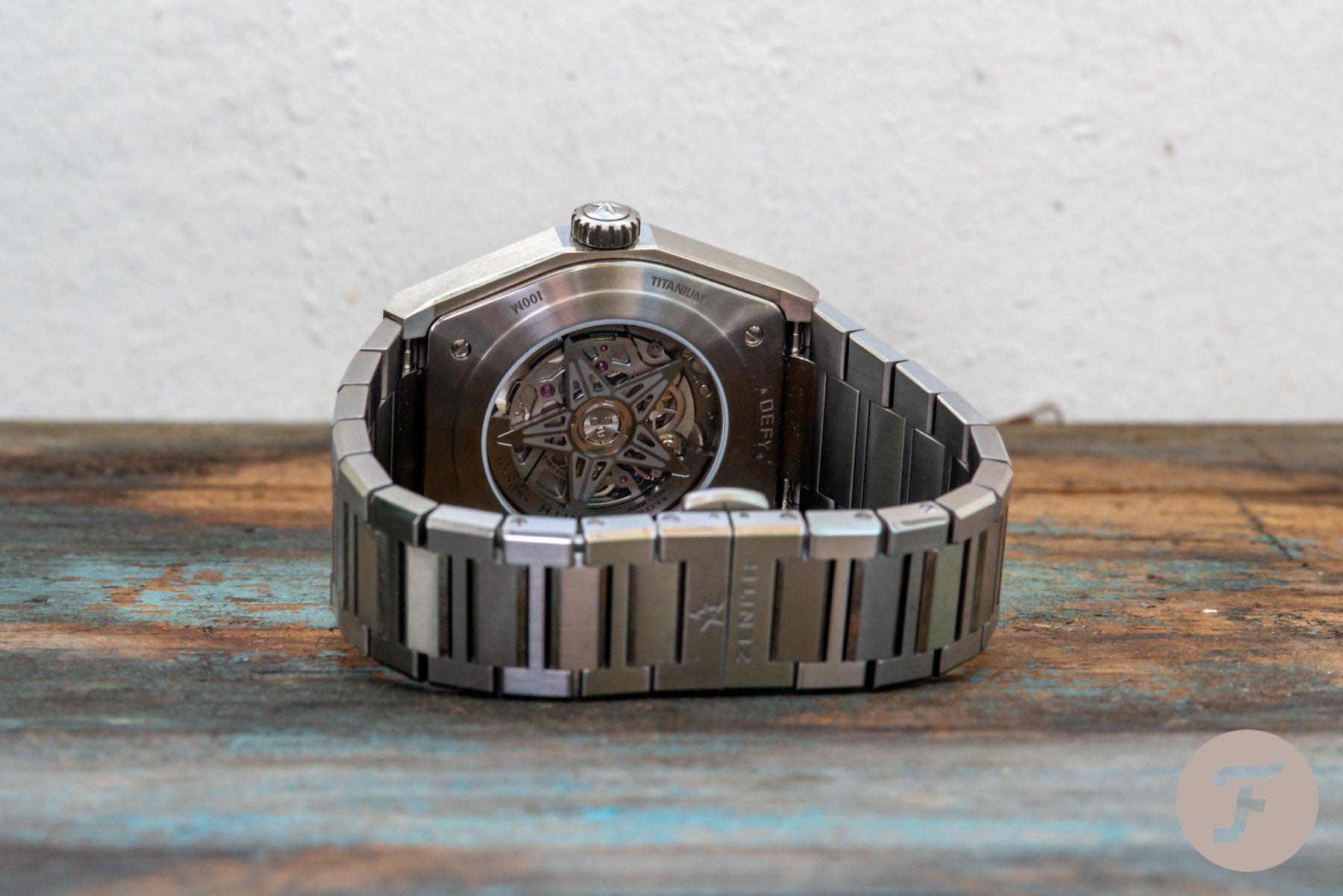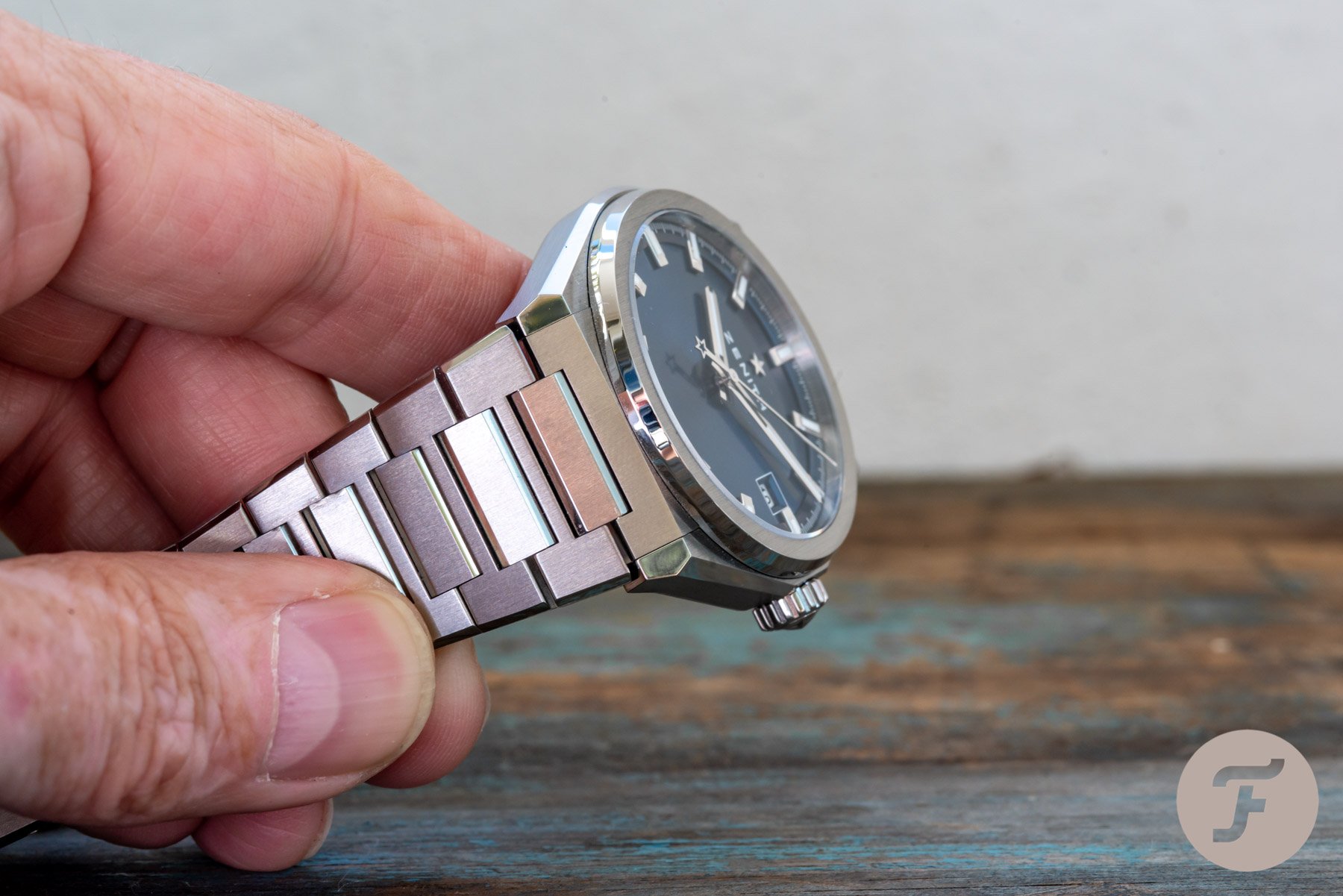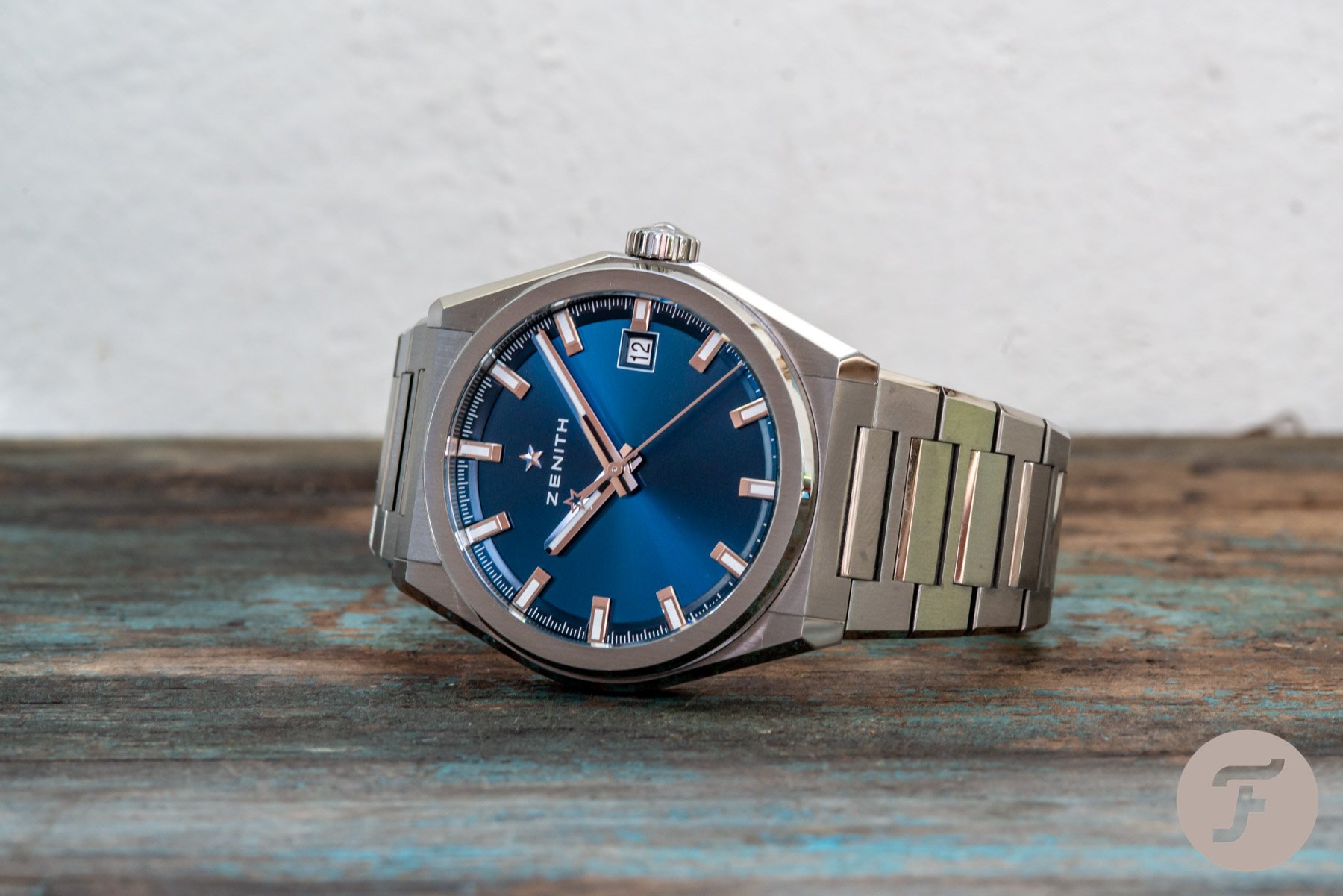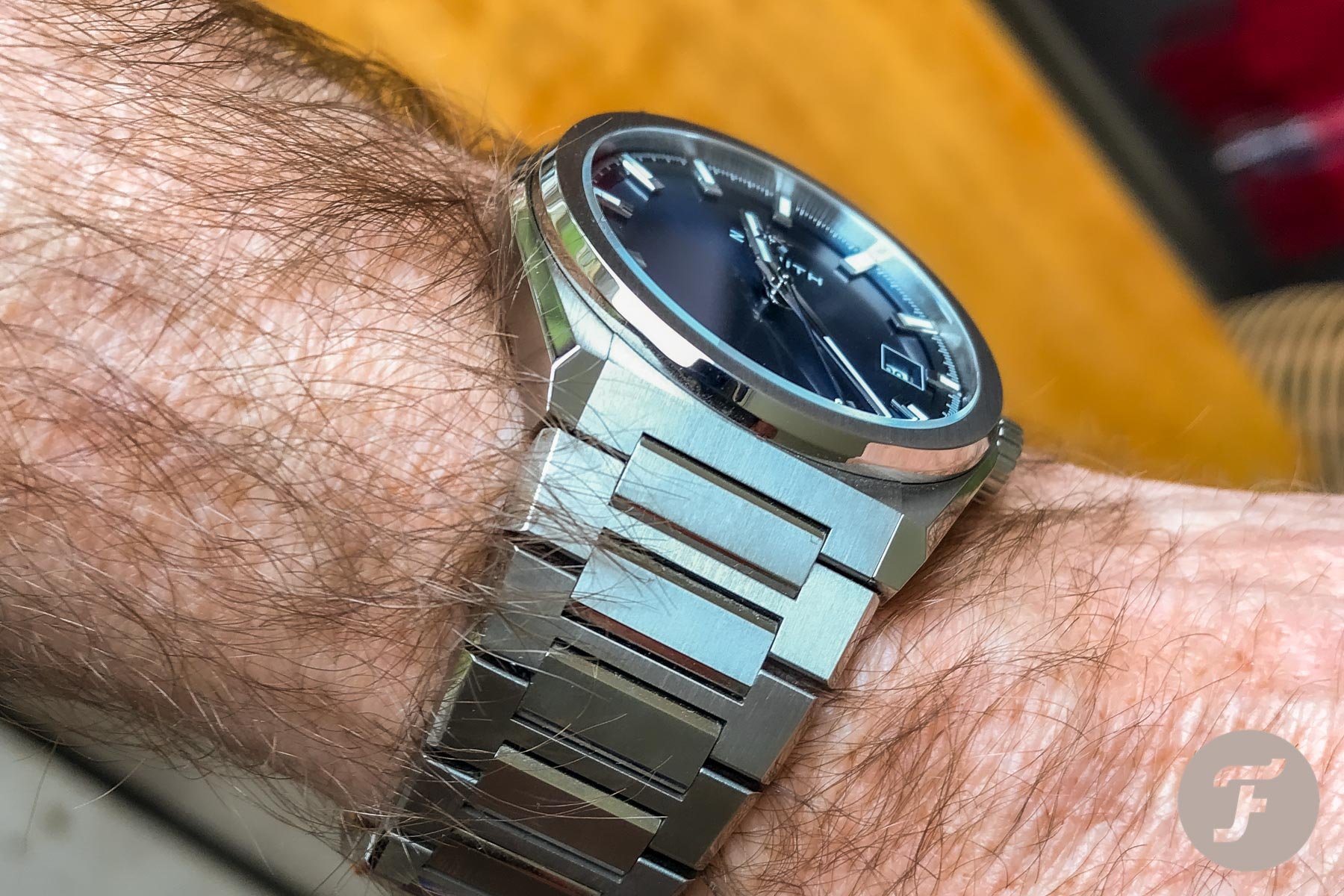Zenith DEFY Classic 41 mm, a week and more on the wrist
Although Zenith still produces watches way beyond my comfort zone, I’m glad they remember and honor their past as well. In most of the currently available model lines (DEFY, Chronomaster, Elite, and Pilot), conservative models can be found. I see the Zenith DEFY Classic 41 mm as one of them.
I’m a great fan of most integrated bracelet(*) watch models. So yes, I like the Patek Philippe Nautilus, the Audemars Piguet Royal Oak, the IWC Ingenieur, and the Vacheron Constantin 222 and Overseas. I like the Girard Perregaux Laureato, and I could have liked the Piaget Polo S if its bracelet, quality-wise, hadn’t been such a disaster. Ultimately, I have to admit that it even might be possible that I’m going to like the new Bell & Ross BR05 after I can try it on my wrist.
And so it happened that, before I really realized, I found myself buying and wearing one of the new DEFY Classic models. At this point, I want to mention that reviewing one of my private watches might cause this article to be slightly biased. But of course, I’ll try to be professional and neutral.
Zenith DEFY Classic in Titanium
Shortly after its presentation, beginning of 2018, we had prototypes of the Zenith DEFY Classic in our office and studio for review and pictures. You’ll find Robert-Jan’s hands-on review here. Those were not models with a metal bracelet though. And here, I’d like to explain the (*) which I mentioned above. Technically the Zenith DEFY Classic is not an integrated bracelet watch. The bracelet is removable and could even be replaced by a leather or rubber strap. However, the construction of mounting the bracelet to the watch case is so ingenious that it’s hardly visible; the bracelet seems to be one with the watch case.
Design of an integrated bracelet watch
It proved difficult lately to introduce a watch with an integrated bracelet without being accused of copycatting Gerald Genta. The above mentioned Piaget Polo S was a good example, design-wise it should be a sure combination of the Nautilus and Royal Oak. More or less the same as what’s now being said about the newly introduced Bell & Ross BR05.
… similarities in design
So this Zenith DEFY Classic with bracelet got its share as well. It’s said that the design is mainly stolen from the Royal Oak, with a good second place for the IWC Ingenieur. Of course, I can see similarities in these designs as well, but hey, what do you think? They’re all wristwatches and share the same design construction of an integrated bracelet. All of the watches I mentioned in my second paragraph share this and thus share certain design similarities – designed by Gerald Genta or not. These design similarities are probably why I like them, and it was why I chose for the Zenith DEFY Classic with a titanium bracelet.
The dial, blue is the new black
Or green, or brown, or white, or what else. Although I love to look at watch technics, the skeletonized version of this DEFY Classic is not for me. I like simplicity more. And the simple version of the DEFY Classic comes with a beautiful blue dial. Slightly metallic but not to the extent that it becomes shiny. A slight sunburst is only decerned under certain light conditions.
… simplicity is key
For the rest, careful simplicity, it seems. Compared to the prototypes it should be noticed that Zenith decided to ditch the ‘D E F Y’ designation in the dial. Already happy with the lack of ‘Automatic’, they couldn’t have made me happier. Usually not a fan of a date-window at all, in this plain open dial the date window becomes almost a must. And what a date window it is. Carefully white outlined it has sloped sides towards the opening showing a perfectly aligned number on the date disc. In general, I would have preferred a date disc matching the dial color. Here I’m glad it’s white. It suits way better to the white index markers around the dial, and I expect it’s easier to read as well.
Awesome index markers
Mentioning the index markers; they’re polished, beveled, and filled with externally white Super-LumiNova, glowing blue-greenish. But even more, fitted to the glass ring instead of to the dial itself, the index markers float above the dial. I must admit that I only noticed this while taking macro shots of the watch. But once seen it can’t be unseen, it’s what provides that beautiful depth in the dial.
… index markers floating above the dial
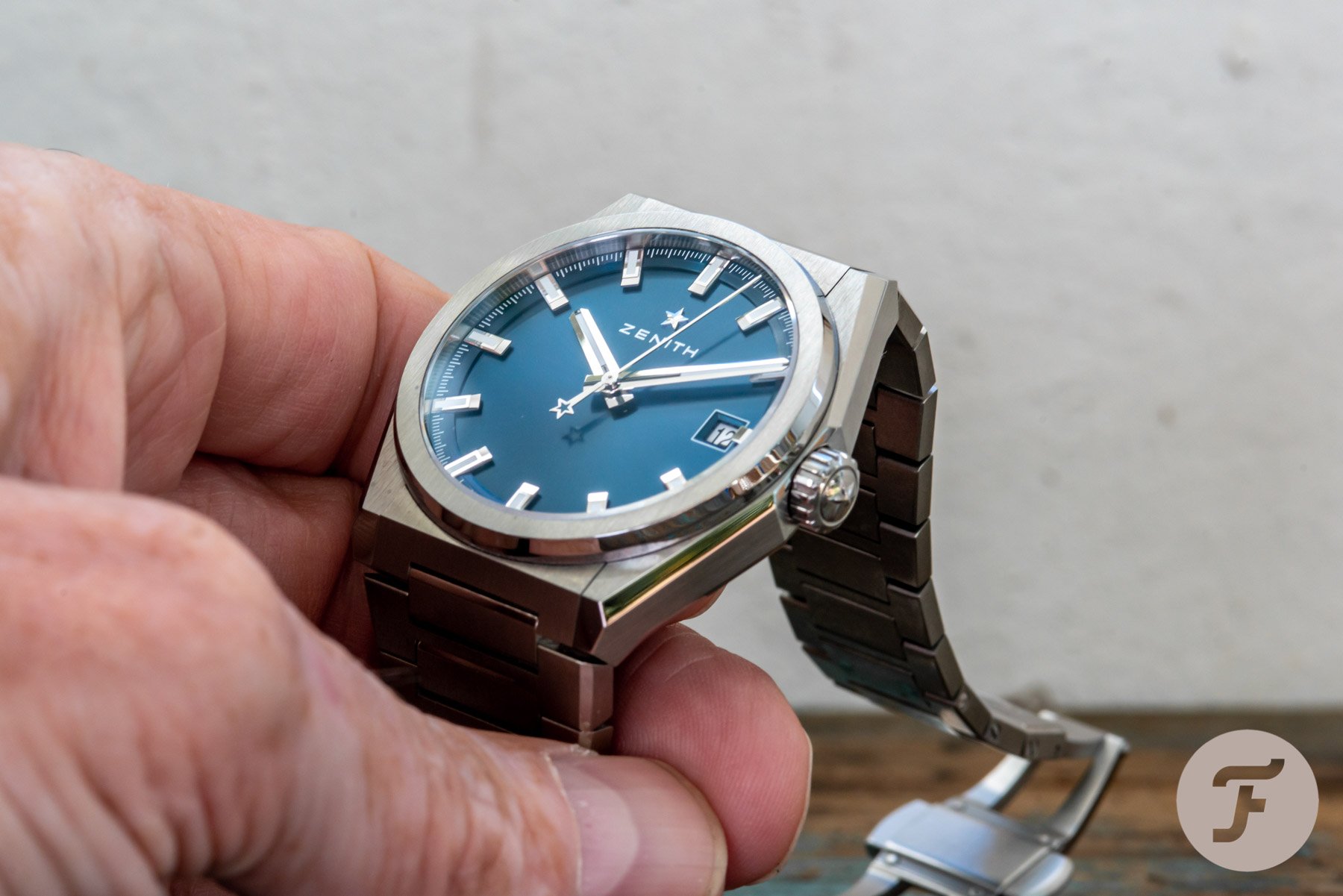 Notice the index markers
Notice the index markersThe hands perfectly fit the index markers, have an adequate length, and are extremely well finished. Even the sides, something which some manufacturers easily forget. The star at the end of the – non-luminous – second hand can be seen as the cherry on the cake. The space between each second on the minute track (that’s a bit odd, isn’t it?) is divided into four lines, how it should be for a 28,800/h = 8 Hz frequency movement. All printing – like Zenith, Swiss Made, and the minute track – in the dial is entirely white. A polished applied Star is found as a logo above the Zenith brand name.
Facets and facets
Leaving the dial brings us to the watch’ casing. In titanium, that is. A masterpiece I would say, certainly in terms of form and finishing. Describing the shape is complicated. It’s not round, it’s not square, it’s not tv-shaped, nor tonneau. Although the latter would come closest. It looks like a classic C-shape case, but the sides are not rounded. From the center of the case, and from the crown, down to the lugs, the sides are a straight line. And then the bezel and dial are circle-shaped, differentiating it from many similar designed integrated bracelet watches.
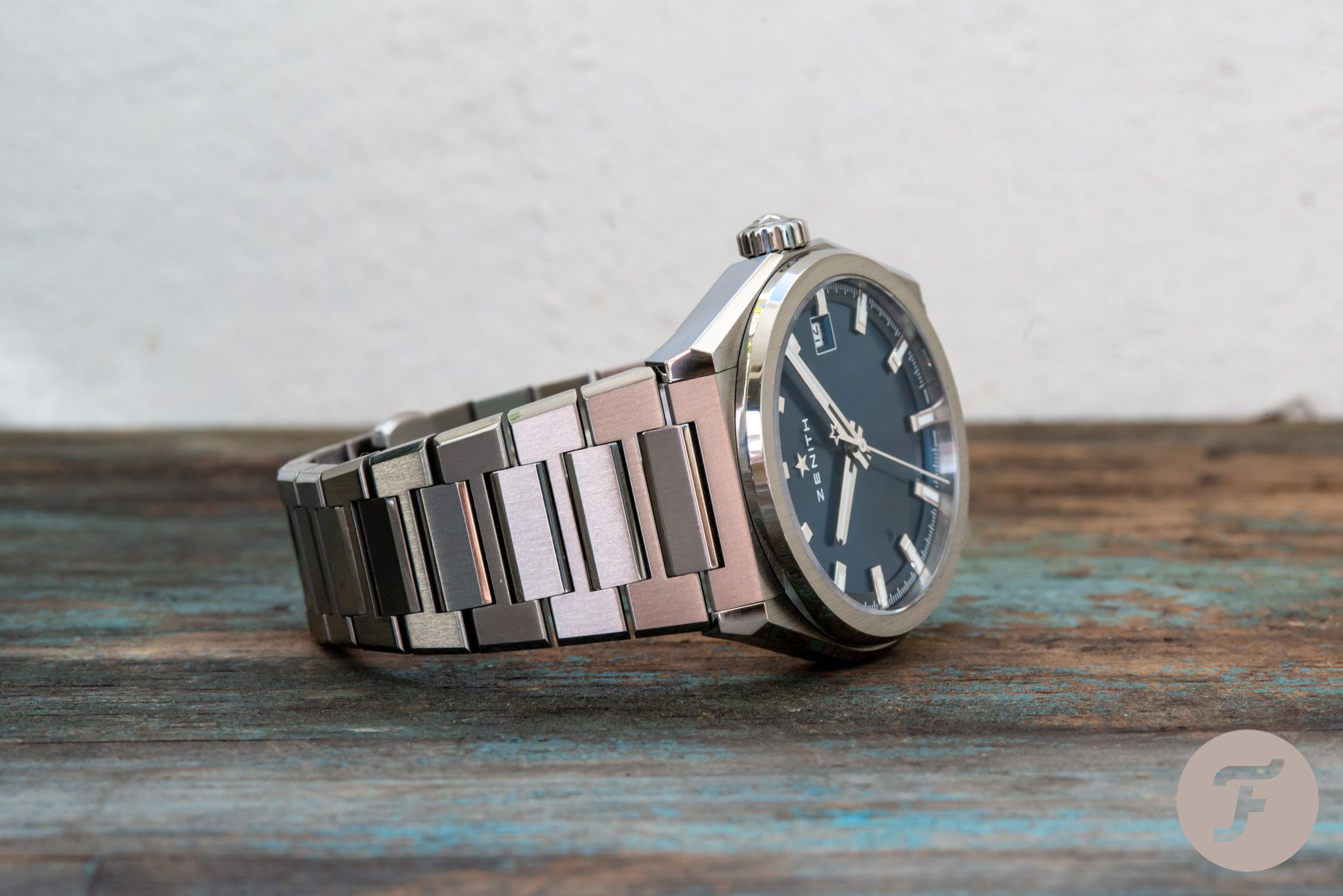 The many facets of the case and bracelet
The many facets of the case and braceletBesides its specific shape, there’s something else which is extraordinary, and that’s the finishing of the case. The longer you look, the more facets appear. And the good thing is, they’re alternately finished polished and brushed. Let’s go for some examples. The top of the bezel, brushed. Sloped sides of the bezel, polished. Top of the casing brushed. Edge of the housing, polished. Side of the casing, brushed. The sloped bottom edge of the casing, polished. The caseback, brushed. Sloped end of lugs, polished. Outside of bracelet, brushed. Edged sloped sides of the bezel and sloped sides of the center links, polished. Of course, I understand that I meanwhile lost you there. This is the time to have a closer look at some of the pictures to understand what I was trying to explain.
… a bracelet matching the best of bracelets known in the industry
I mentioned the bracelet already, with its beautifully executed facets on its edges and center links. The feel is fantastic as well; titanium wears like a charm. And then the tapering. Coming from a width of 25 mm at the case (lug width is 22 mm), and tapering equally over more than half of the length of the bracelet to not even 18 mm at the folding clasp. That’s an awesome bracelet, matching the best of bracelets known in the industry.
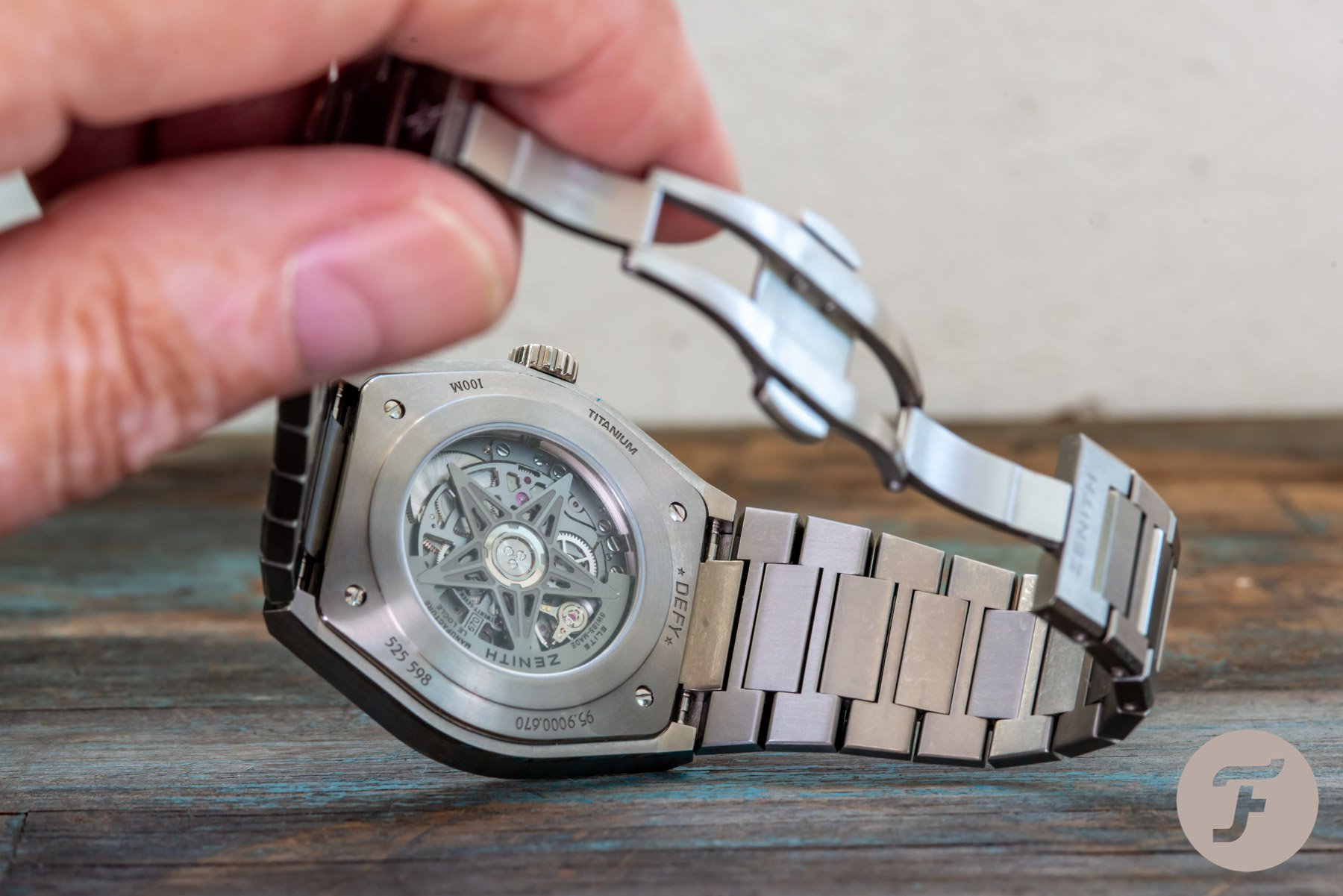 The Zenith 670SK caliber
The Zenith 670SK caliberSkeletonized movement
Somewhere at the start of this article, I mentioned the skeletonized version of the Zenith DEFY Classic, and it not being my kind of beer. Through the sapphire glass case back it’s nice to see, however, that even in this version with the plain dial Zenith uses the Elite 670SK caliber. And SK stands for Skeletonized. Gazing through the skeletonized bridges, you should be able to see the silicon escape wheel and lever.
Price and comparison
Coming to the end of this review, something which is left to discuss is the price of this Zenith DEFY Classic 41 mm in Titanium. Bluntly, that price (in Europe) is € 6.500,= including 21% VAT, or sales tax. I have to admit, a lot of money but here’s why I think that it’s not expensive. We’re looking at a watch of an authentic brand with a highly respected and experienced in-house movement, and in a titanium case with a titanium bracelet. I don’t want to go Nautilus and Royal Oak in my comparison, I know that, for all sorts of reasons, that’s another league.
… I won’t go Nautilus and Royal Oak
But what about the current time-only Vacheron Constantin Overseas? In my opinion, the Zenith, including its manufacture movement, holds up to the quality and feel of that watch. But, the VC comes in stainless steel at just over € 20.000,=. How about the Girard-Perregaux Laureato then? In-house movement, but as well in stainless steel, and costs just over € 10.000,=. Actually, I don’t want to compare the Piaget Polo S because of its inferior quality bracelet. But here as well, in stainless steel with a Cartier 1904-based caliber, it has a price of around € 9.000,=.
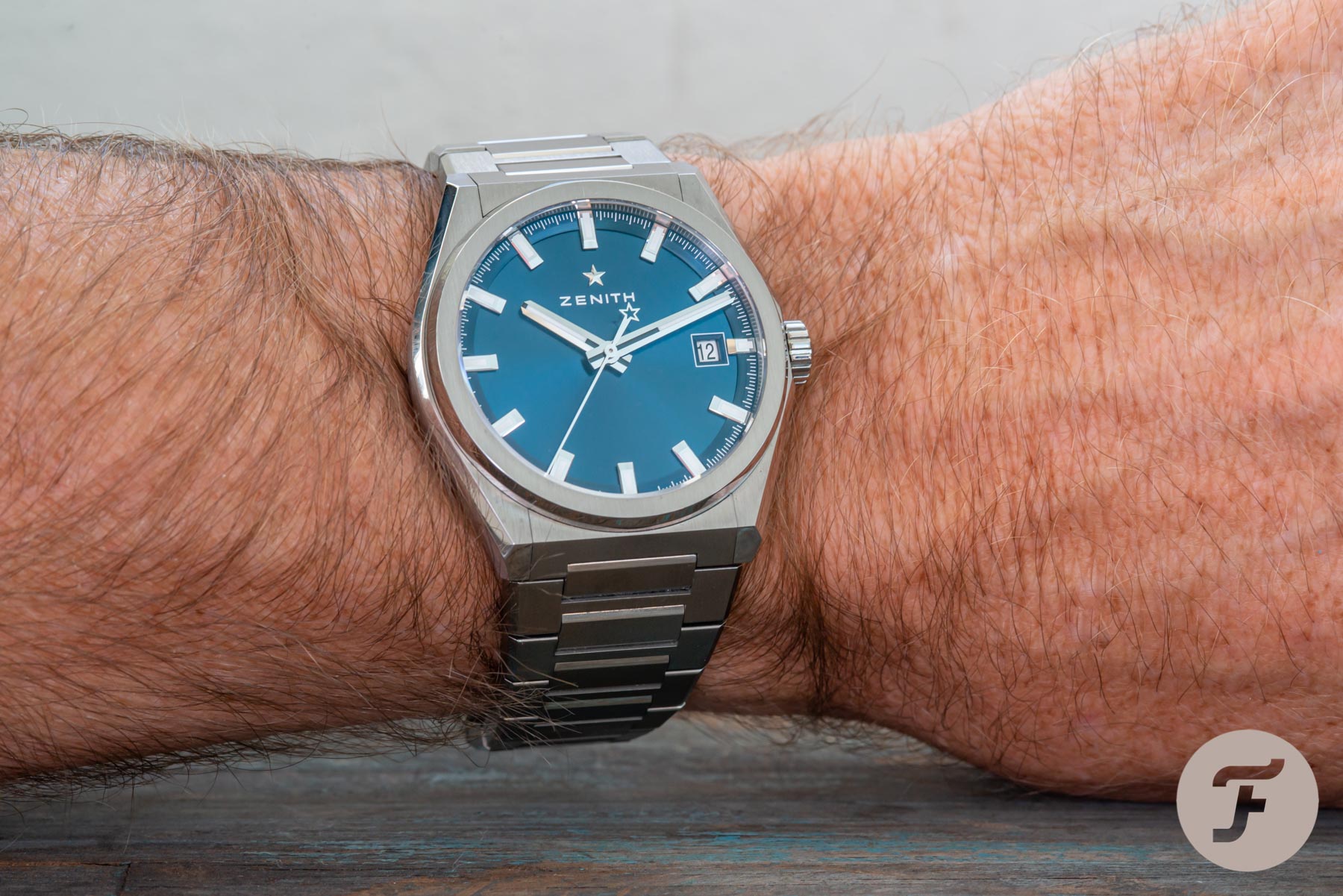 The Zenith DEFY Classic 41 mm on my 17.5 – 18 cm wrist
The Zenith DEFY Classic 41 mm on my 17.5 – 18 cm wristCorrect me if I’m wrong, but again, I don’t think at € 6.500,= the Zenith DEFY Classic is an expensive watch. In my opinion beautiful though, and a real pleasure to wear.
… what’s not to be liked about this watch?
Aren’t there any negatives points to mention about the Zenith DEFY Classic? If I have to name one, and only if I have to, I would mention the watch probably being prone to scratches and dings. With so many extremely detailed and sharp edges, changes to even slightly hit one of them has to be foreseen. Although even after wearing the watch for almost two consecutive weeks now I’m glad I can’t find any, with the bare eye visual, damage. End of this love letter.
More information via Zenith online.

